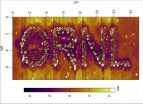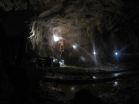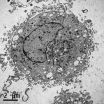(Press-News.org) OAK RIDGE, Tenn., Dec. 17, 2014--Scientists at the Department of Energy's Oak Ridge National Laboratory have used advanced microscopy to carve out nanoscale designs on the surface of a new class of ionic polymer materials for the first time. The study provides new evidence that atomic force microscopy, or AFM, could be used to precisely fabricate materials needed for increasingly smaller devices.
Polymerized ionic liquids have potential applications in technologies such as lithium batteries, transistors and solar cells because of their high ionic conductivity and unique structure. But many aspects of the recently discovered materials are still not well understood.
When ORNL researchers used an atomic force microscope to begin characterizing the properties of polymerized ionic liquid thin films, the experiment yielded some surprising results.
"We were expecting to measure ionic conductivity, and instead we found that we were forming holes on the surface," said ORNL's Vera Bocharova, corresponding author on the study published in Advanced Functional Materials. "Then we started to think about how this might have great applications in nanofabrication."
Nanolithography is the dominant technique used by industry for nanofabrication, but its size limitations are leading researchers to explore other methods such as AFM.
"This study is part of our search for alternative methods and materials that can be used to create smaller sized objects," Bocharova said. "For example, our technique might be interesting for the miniaturization of semiconductor technology."
Similar AFM techniques have been used to study and produce patterns in nonconductive polymers, but the ORNL study uncovered several differences in the application to polymerized ionic liquids.
"In comparison to nonconductive polymers, we have to apply less bias -- four volts instead of 20 volts -- to generate the holes, which is good in terms of energy savings for future applications," Bocharova said.
In nonconductive polymers, the high voltage applied through the AFM tip punctures the material's surface by localized heating. In contrast, the ORNL team used experiment and theory to determine that the holes formed in the conductive polymer liquids resulted from negative ions migrating to the positively charged microscope tip. The researchers plan to continue refining the technique's capabilities and their understanding of the polymerized ionic liquids' properties.
"Right now the size of the formed features is in the range of 100 nanometers, but it's not the limit," Bocharova said. "We believe it's possible to change the experimental setup to advance to lower scales."
INFORMATION:
The paper is published as "Controlled Nanopatterning of a Polymerized Ionic Liquid in a Strong Electric Field." Coauthors are ORNL's Vera Bocharova, Alexander Agapov, Alexander Tselev, Rajeev Kumar, Alexander Kisliuk, Ivan Kravchenko, Bobby Sumpter, Alexei Sokolov, Sergei Kalinin, and Evgheni Strelcov; Liam Collins of the University College Dublin; and Stefan Berdzinski and Veronika Strehmel of the Hochschule Niederrhein University of Applied Sciences. Sokolov holds an ORNL-University of Tennessee Governor's Chair appointment.
This research was supported by ORNL's Laboratory Directed Research and Development program and was conducted in part at ORNL's Center for Nanophase Materials Sciences, a DOE Office of Science User Facility. Parts of the research were supported by DOE's Office of Science and the National Science Foundation.
ORNL is managed by UT-Battelle for the Department of Energy's Office of Science. DOE's Office of Science is the single largest supporter of basic research in the physical sciences in the United States, and is working to address some of the most pressing challenges of our time. For more information, please visit http://science.energy.gov.
Image: http://www.ornl.gov/Image%20Library/Main%20Nav/ORNL/News/News%20Releases/2014/bocharova_highres.png?code=094e4d45-de23-41c2-b5c5-aac721bddaaf
Caption: Oak Ridge National Laboratory researchers used atomic force microscopy to draw nanoscale patterns in a polymerized ionic liquid.
NOTE TO EDITORS: You may read other press releases from Oak Ridge National Laboratory or learn more about the lab at http://www.ornl.gov/news. Additional information about ORNL is available at the sites below:
Twitter - http://twitter.com/ornl
RSS Feeds - http://www.ornl.gov/ornlhome/rss_feeds.shtml
Flickr - http://www.flickr.com/photos/oakridgelab
YouTube - http://www.youtube.com/user/OakRidgeNationalLab
LinkedIn - http://www.linkedin.com/companies/oak-ridge-national-laboratory
Facebook - http://www.facebook.com/Oak.Ridge.National.Laboratory
UCLA researchers have developed a lens-free microscope that can be used to detect the presence of cancer or other cell-level abnormalities with the same accuracy as larger and more expensive optical microscopes.
The invention could lead to less expensive and more portable technology for performing common examinations of tissue, blood and other biomedical specimens. It may prove especially useful in remote areas and in cases where large numbers of samples need to be examined quickly.
The microscope is the latest in a series of computational imaging and diagnostic devices ...
VIDEO:
It's official -- our holiday lights are so bright we can see them from space. Thanks to the VIIRS instrument on the Suomi NPP satellite, a joint mission between NASA...
Click here for more information.
Even from space, holidays shine bright.
With a new look at daily data from the NOAA/NASA Suomi National Polar-orbiting Partnership (Suomi NPP) satellite, a NASA scientist and colleagues have identified how patterns in nighttime light intensity change during major holiday ...
The sun emitted a mid-level solar flare, peaking at 11:50 p.m. EST on Dec. 16, 2014. NASA's Solar Dynamics Observatory, which watches the sun constantly, captured an image of the event. Solar flares are powerful bursts of radiation. Harmful radiation from a flare cannot pass through Earth's atmosphere to physically affect humans on the ground, however -- when intense enough -- they can disturb the atmosphere in the layer where GPS and communications signals travel.
To see how this event may affect Earth, please visit NOAA's Space Weather Prediction Center at http://spaceweather.gov, ...
In the first real-world trial of the impact of patient-controlled access to electronic medical records, almost half of the patients who participated withheld clinically sensitive information in their medical records from some or all of their health care providers.
This is the key finding of a new study by researchers from Clemson University, the Regenstrief Institute, Indiana University School of Medicine and Eskenazi Health published in the Journal of General Internal Medicine.
Kelly Caine, assistant professor in Clemson's School of Computing, and colleagues at Clemson ...
A team of scientists, led by the University of Toronto's Barbara Sherwood Lollar, has mapped the location of hydrogen-rich waters found trapped kilometres beneath Earth's surface in rock fractures in Canada, South Africa and Scandinavia.
Common in Precambrian Shield rocks - the oldest rocks on Earth - the ancient waters have a chemistry similar to that found near deep sea vents, suggesting these waters can support microbes living in isolation from the surface.
The study, to be published in Nature on December 18, includes data from 19 different mine sites that were ...
Chemical modifications to DNA's packaging -- known as epigenetic changes -- can activate or repress genes involved in autism spectrum disorders (ASDs) and early brain development, according to a new study to be published in the journal Nature on Dec. 18.
Biochemists from NYU Langone Medical Center found that these epigenetic changes in mice and laboratory experiments remove the blocking mechanism of a protein complex long known for gene suppression, and transitions the complex to a gene activating role instead.
Researchers say their findings represent the first link ...
LA JOLLA, CA--December 17, 2014--Chemists at The Scripps Research Institute (TSRI) have invented a powerful method for joining complex organic molecules that is extraordinarily robust and can be used to make pharmaceuticals, fabrics, dyes, plastics and other materials previously inaccessible to chemists.
"We are rewriting the rules for how one thinks about the reactivity of basic organic building blocks, and in doing so we're allowing chemists to venture where none has gone before," said Phil S. Baran, the Darlene Shiley Chair in Chemistry at TSRI, whose laboratory reports ...
Johns Hopkins and University of Alberta researchers have identified a single protein as the root of painful and dangerous allergic reactions to a range of medications and other substances. If a new drug can be found that targets the problematic protein, they say, it could help smooth treatment for patients with conditions ranging from prostate cancer to diabetes to HIV. Their results appear in the journal Nature on Dec. 17.
Previous studies traced reactions such as pain, itching and rashes at the injection sites of many drugs to part of the immune system known as mast ...
Researchers found 53 existing drugs that may keep the Ebola virus from entering human cells, a key step in the process of infection, according to a study led by researchers at the Icahn School of Medicine at Mount Sinai and the National Institutes of Health (NIH), and published today in the Nature Press journal Emerging Microbes and Infections.
Among the better known drug types shown to hinder infection by an Ebola virus model: several cancer drugs, antihistamines and antibiotics. Among the most effective at keeping the virus out of human cells were microtubule inhibitors ...
Researchers from Intermountain Medical Center in Salt Lake City have identified a new "sliding scale" model used to rule out potentially deadly blood clots in the lungs, known as pulmonary embolisms, that is more accurate than current diagnostic methods.
The new model, which factors in a patient's age, more accurately identifies a patient's risk of the often-deadly blood clots and can more easily rule out the need for additional, more invasive tests, helping to reduce unnecessary costs.
The research is published in the medical journal, CHEST.
Pulmonary embolism is ...






